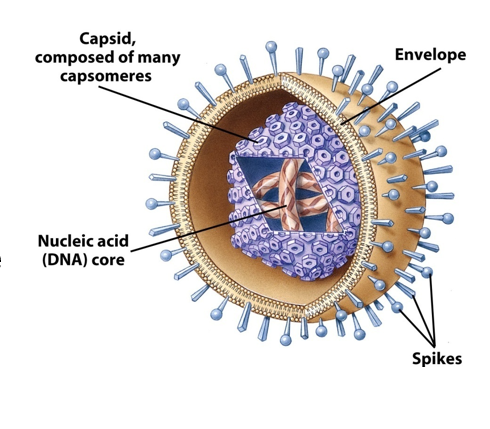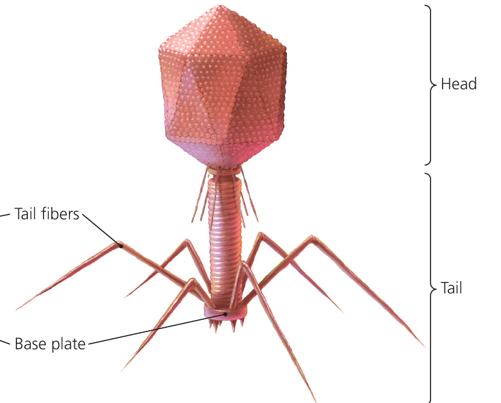Microbiology Chapter 13 EXAM
1/55
There's no tags or description
Looks like no tags are added yet.
Name | Mastery | Learn | Test | Matching | Spaced |
|---|
No study sessions yet.
56 Terms
True or false: you can have single DNA, double DNA, single RNA, and double RNA. Multiple in one virus.
FALSE - you can have any of the 4 listed but not more than one within a virus.
Where does the viral envelope come from?
The envelope comes from the host’s membrane. Enveloped viruses are more weak in their environment (soap) but stronger within the body.
How are viruses classified?
type of nucleic acid - single or double DNA/RNA
presence of an envelope - naked vs envelope around capsid
shape - viruses form different shapes → helical, polyhedral, complex
size - can vary
What committee is responsible for classification?
The international committee on taxonomy of viruses (ICTV) is responsible for classification, naming, & recognizing the family / genus names.
True or false: viruses are acellular
TRUE
Explain why viruses are considered “obligate intracellular parasites”
They can never live on their own outside of a host body. They must be inside of a host cell to grow and replicate.

Draw a typical animal virus and label the components. Explain the function of each component.
Viral genome (nucleic acid core): DNA or RNA (single or double)
Helical capsid: protein coat surrounding the nucleic acid that protects it & aids in the delivery of host cells
Envelope: phospholipid bilayer membrane surrounding the outside of the capsid; derived from host membrane
Glycoproteins: spike-like structures embedded in the viral envelope, crucial for attachment to the host cell
What is a capsomere and where are they found?
Capsomere = protein subunits (single or multiple types of proteins) that make up the capsid of a virus
Function: protection around genome, attachment of virus to host, structural integrity
What is a complete virus particle called?
Virion → includes a nucleic acid, capsid, and sometimes an envelope
When would a virus be considered “naked”?
Naked viruses are very resistant in the environment/outside the body. Die once in the body.
Naked virus = lacks an envelope and only consists of a nucleic acid core & capsid
released through exocytosis (when host cell dies)
Briefly describe the variations in viral shapes and sizes.
Helical = consists of a ribbon-like protein that forms a spiral around the nucleic acid (rod-shaped)
Polyhedral = many-sided, one of the most common is the icosahedron; smaller and round
Complex = have an elaborate capsid, varied shapes; bacteriophage

What are the parts of a bacteriophage?
The head, tail, base plate, and tail fibers
What type of hosts can be infected by viruses?
They can infect any living hosts (humans, animals, bacteria, protozoa, archaea, fungi).
viruses are highly specific, targeting particular host cells due to affinity between viral attachment & host cell surface proteins
generalist viruses → can infect multiple hosts
diverse host range
viral interactions → larger viruses can be infected by smaller viruses
True or false: the envelope of a virus is more susceptible to detergents and drying
TRUE
What is the size of a virus?
They can range from 20 nm to 900 nm
must use an electron microscope to view them
Which family is coronavirus from?
Coronaviridae
Herpesvirus
creeping
can be latent for years
ex: herpes, chickenpox
Poxvirus
smallpox killed more than 500 million
smallpox first virus eradicated → 1980
Picornaviruses
very small
naked
polyhedral RNA viruses
Retroviruses
contain the enzyme reverse transcriptase
HIV
Paramyxovirus
near mucus membranes
Rhabdoviruses
rabies can infect mammals
Filoviruses
direct contact → blood, semen, needles
Ebola
True or false: the glycoprotein spike acts as a lock and key
TRUE
Describe the types of RNA viruses and some of the differences between them and DNA viruses, Name a few examples of each type.
+ sense = acts like mRNA; - sense = template for mRNA
positive-sense RNA = can serve as mRNA for protein synthesis (coronavirus)
negative-sense RNA = template; requires transcription into positive-sense RNA by RNA polymerase before protein synthesis (lyssavirus → rabies + influenza)
double-stranded RNA = each strand serves as a template for its complement
Differences = RNA mutates faster due to no proofreading & DNA has more stable genomes
Bacteriophage replication lytic cycle
Lytic replication = usually results in death & lysis of host cell
Always Play By My Rules
Attachment = virus attaches to host cell surface
Penetration = entry of virions into host cell (at least the genome)
Biosynthesis = making new nucleic acids, capsid proteins, and other viral components
Maturation = assembly of newly synthesized viral components into complete virions
Release = departure of newly made virions by killing their host cells
What type of phages undergo the lytic cycle?
virulent phages
Viral growth curve
stage 1: infection (inoculation phase)
stage 2: eclipse phase → virus binds & penetrates the host cell
stage 3: burst → virions are released from lysed host cells at same time
What is the number of virions released per bacterium called?
the BURST SIZE
Lysogenic cycle
Attachment & Entry = similar to the lytic cycle
Prophage formation = viral DNA integrates into the host’s chromosome, becoming a prophage
Replication = prophage is replicated with the host’s DNA during cell division
Induction = prophage may exit the host chromosome, entering the lytic cycle
(in binary fission each daughter cell will receive a phage of DNA)
What type of phages undergo the lysogenic cycle?
temperate phages
called a prophage during its inactive state
When viral DNA is inserted into a bacterial chromosome, it is called a __________, which is part of the ____________ cycle.
Propahage (inactive state) = integrates into host DNA & replicates along the chromosome
Lysogenic
What is an advantage of the lysogenic cycle over the lytic cycle?
The lytic cycle kills the host cell
The lysogenic cycle incorporates into the host, allowing the virus to persist without causing as much harm.
prophage integrates into chromosome, allowing viral DNA to be replicated with the host’s DNA
prophage can remain dormant in geome for many generations without killing the host
lysogenic conversion = prophage can alter phenotype, turning it into a pathogen that produces other toxins
The period of time required to complete the lytic cycle is called…
the burst time
What is the connection between viruses and cancer?
proto-oncogenes are kept in check by repressors
viral insertion → 1st hit the virus may insert a promoter next to a proto-oncogene turning it into an oncogene
second hit & cancer development → disrupts repressor & allows cancer formation
What environmental factors are linked to cancer?
UV, radiation, carcinogens, viruses
What percentage of cancers do viruses cause?
20-25% of cancers
What are prions? What are some human diseases caused by prions?
Prions = infectious protein particles that lack nucleic acids. They replicate by inducing normal proteins, a-helices made by mammals known as cellular PrP → misfolded b-pleated sheets (prion PrP) which cause disease.
Ex: spongiform encephalopathies → variant creutz-feldt-jacob disease & chronic wasting disease
What are viriods?
Extremely small, circular pieces of ssRNA without a capsid that cause disease in plants.
does not code for proteins; adheres to complementary plant RNA
plant enzyme degrades dsRNA → disease state
How is the T4 virus able to penetrate E. Coli’s cell wall?
It releases lysozyme, which weakens the cell wall.
If one virus particle infects a cell, approximately how many infectious virus particles are present during the synthesis step of the virus replication cycle?
0
Which is not a way that viruses can cause human cancer?
viruses can cause abnormalities in the host cytoplasmic membranes
What is accepted argument for why viruses should be considered living?
they possess genomes with instructions for replicating themselves
What is a difference between phage T4 and lambda phage?
Phage T4 uses lytic replication; lambda follows lysogenic replication
Virus
miniscule, acellular, infectious agent composed of nucleic acid surrounded by a protein coat (capsid).
can be extracellular or intracellular (virus lacks a capsid & exists solely as nucleic acid)
Virion
complete, extracellular form of a virus
includes nucleic acid, capsid, sometimes an envelope
the virion is the infectious form of a virus outside of a host cell
Fungal virus
exists only within cells
no extracellular state
spread through membrane fusion
Plant viruses
enter through abrasions or via plant parasites
agricultural damage
Bacterial viruses
highly specific
very numerous
Sars-CoV-2
enveloped virus with a + ssRNA
helical capsid with envelope + spike proteins
enters through respiratory droplets
Viruses evolve quickly because..
genetic material (ssRNA mutation)
using host cell to replicate leads to mutation
selective immune system pressure (new strains)
Bacteriophage vs animal virus replication
attachment = bacteriophages attach with tail fibers; animal viruses attach using glycoproteins
entry = bacteriophages only inject their nucleic acid; entire virion of animal virus enters cell → uncoating
replication environment = bacteriophages replicate in prokaryotes; animal viruses in eukaryotic cells (no cell wall)
release = bacteriophages kill host cell to release; animal viruses kill host cell or undergo budding
Neoplasia
uncontrolled cellular division in animals
Malignant tumors
cancer
Metastasis
tumor spreads
What are the 3 mechanisms of entry of animal viruses?
direct penetration → naked viruses inject genome into host cell
membrane fusion → enveloped viruses dump capsid into cell
endocytosis → can be naked or enveloped virus (engulf)